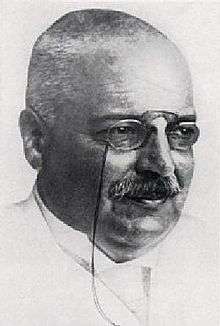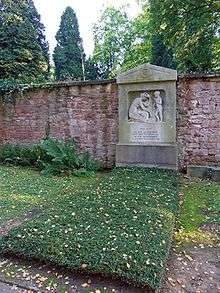Alois Alzheimer
| Aloysius Alzheimer | |
|---|---|
 Dr. Aloysius Alzheimer | |
| Born |
14 June 1864 Marktbreit, Bavaria |
| Died |
19 December 1915 (aged 51) Breslau, Prussia (now Wrocław, Poland) |
| Cause of death | Heart failure |
| Education |
University of Tübingen University of Würzburg |
| Known for | First published case of "presenile dementia" (Alzheimer's disease) |
|
Medical career | |
| Profession | Psychiatrist, Physician |
| Institutions | Institute for the Insane and Epileptic ("Irrenschloss"), Frankfurt am Main |
| Specialism | Neuropathology |
| Signature | |
 | |
Dr. Aloysius "Alois" Alzheimer (German: [ˈaːloˌis ˈalts.haɪmɐ]; 14 June 1864 – 19 December 1915) was a Bavarian-born German psychiatrist and neuropathologist and a colleague of Emil Kraepelin. Alzheimer is credited with identifying the first published case of "presenile dementia", which Kraepelin would later identify as Alzheimer's disease.[1]
Early life and education
Aloysius Alzheimer was born in Marktbreit, Bavaria on 14 June 1864.[2] His father served in the office of notary public in the family's hometown.[3] The Alzheimers moved when Alois was still young in order to give their children an opportunity to attend the Royal Humanistic Gymnasium. Later, Alois would study medicine in Aschaffenburg, Tübingen, Berlin, and Würzburg Universities. His college years were fairly typical; in his final year of school Alois was on the fencing team and a member of a fraternity, and even received a fine for disturbing the peace while out with his team.[4] In April 1884, he married Cecille Simonette Nathalie Geisenheimer, with whom he had three children. Cecille died in 1901.[4] In 1887, Alois Alzheimer graduated from Würzburg with a degree in medicine.[4]
Career
The following year, he spent five months assisting mentally ill women before he took an office in the city mental asylum in Frankfurt am Main, the Städtische Anstalt für Irre und Epileptische (Asylum for Lunatics and Epileptics). Emil Sioli, a noted psychiatrist, was the dean of the asylum. Another neurologist, Franz Nissl, began to work in the same asylum with Alzheimer. Together, they conducted research on the pathology of the nervous system, specifically the normal and pathological anatomy of the cerebral cortex.[4] Alzheimer was the co-founder and co-publisher of the journal Zeitschrift für die gesamte Neurologie und Psychiatrie, though he never wrote a book that he could call his own.
While at the Frankfurt asylum, Alzheimer also met Emil Kraepelin, one of the best-known German psychiatrists of the time. Kraepelin became a mentor to Alzheimer, and the two worked very closely for the next several years. When Kraepelin moved to Munich to work at the Royal Psychiatric Hospital in 1903, he invited Alzheimer to join him.[4] At the time, Kraepelin was doing clinical research on psychosis in senile patients; Alzheimer, on the other hand, was more interested in the lab work of senile illnesses.[5] The two men would face many challenges involving the politics of the psychiatric community. For example, both formal and informal arrangements would be made among psychiatrists at asylums and universities to receive cadavers.[5] In 1908 he was a professor at the Ludwig Maximilian University and the Neurological and Psychiatric Clinic of the Friedrich-Wilhelm University from 1912 until he fell ill.[4]
Auguste Deter
In 1901, Dr. Alzheimer observed a patient at the Frankfurt Asylum named Auguste Deter. The 51-year-old patient had strange behavioral symptoms, including a loss of short-term memory; she became his obsession over the coming years. Auguste Deter was a victim of the politics of the time in the psychiatric community; the Frankfurt asylum was too expensive for her husband. Mr. Deter made several requests to have his wife moved to a less expensive facility, but Dr. Alzheimer intervened in these requests. Ms. Deter remained at the Frankfurt asylum, where Alzheimer had made a deal to receive her records and brain upon her death.[5] On 8 April 1906, Ms. Deter died, and Dr. Alzheimer had her medical records and brain brought to Munich where he was working in Kraepelin's laboratory. With two Italian physicians, he used the staining techniques of Bielschowsky to identify amyloid plaques and neurofibrillary tangles. These brain anomalies would become identifiers of what later became known as Alzheimer's Disease.
Findings
Alzheimer discussed his findings on the brain pathology and symptoms of presenile dementia publicly on 3 November 1906, at the Tübingen meeting of the Southwest German Psychiatrists.[4] The attendees at this lecture seemed uninterested in what he had to say. The lecturer that followed Alzheimer was to speak on the topic of "compulsive masturbation", which the audience was so eagerly awaiting that they sent Alzheimer away without any questions or comments on his discovery of the pathology of a type of senile dementia.[4] Following the lecture, Alzheimer published a short paper summarizing his lecture; in 1907 he wrote a larger paper detailing the disease and his findings.[4] The disease would not become known as Alzheimer's disease until 1910, when Kraepelin named it so in the chapter on "Presenile and Senile Dementia" in the 8th edition of his Handbook of Psychiatry. By 1911, his description of the disease was being used by European physicians to diagnose patients in the US.[6]
Contemporaries
American Solomon Carter Fuller gave a report similar to that of Alzheimer at a lecture five months before Alzheimer.[4] Oskar Fischer was a fellow German psychiatrist, 12 years Alzheimer's junior, who reported 12 cases of senile dementia in 1907 around the time that Alzheimer published his short paper summarizing his lecture.[7] The two men had different interpretations of the disease, but due to Alzheimer's short life,[7] they never had the opportunity to meet and discuss their ideas.
Death

In August 1912, Dr. Alzheimer fell ill on the train on his way to the University of Breslau, where he had been appointed professor of psychiatry in July 1912. Most probably he had a streptococcal infection and subsequent rheumatic fever leading to valvular heart disease, heart failure and kidney failure. He never recovered completely from this illness. He died of heart failure on 19 December 1915, at the age of 51 in Breslau, Silesia (present-day Wrocław, Poland). He was buried on 23 December 1915 next to his wife in the Hauptfriedhof in Frankfurt am Main.
Critics and rediscovery
In the early 1990s, critics began to question Alzheimer's findings and form their own hypotheses based on Alzheimer's notes and papers. Amaducci and colleagues hypothesized that Auguste Deter had metachromatic leukodystrophy, a rare condition in which accumulations of fats affect the cells that produce myelin.[8] Another hypothesis offered by Claire O'Brien was that Auguste Deter actually had a vascular dementing disease.[6][8] Through extremely fortunate circumstances the original microscope preparations on which Alzheimer based his description of the disease were rediscovered in 1998 in Munich, and his findings could thus be reevaluated.[9] The slides confirmed that Auguste Deter did in fact have what is now known as Alzheimer's Disease.
Other interests
Alzheimer was known for having a variety of medical interests including vascular diseases of the brain, early dementia, brain tumors, forensic psychiatry and epilepsy.[10] Alois Alzheimer was also a leading specialist in histopathology in Europe.[10] His colleagues knew him to be a dedicated professor and cigar smoker.[4]
See also
References
- ↑ Berrios G E (1991) Alzheimer’s Disease: A Conceptual History. International Journal of Geriatric Psychiatry 5: 355-365
- ↑ Zilka, N.; M. Novak (2006). "The tangled story of Alois Alzheimer" (PDF). Bratisl Lek Listy. 107 (9–10): 343–345. PMID 17262985. Retrieved 2012-09-04.
- ↑ "Marktbreit: Alzheimer´s Birthplace"
- 1 2 3 4 5 6 7 8 9 10 11 Cipriani, Gabriele; Dolciotti, Cristina; Picchi, Lucia; Bonuccelli, Ubaldo (2010-12-11). "Alzheimer and his disease: a brief history". Neurological Sciences. 32 (2): 275–279. doi:10.1007/s10072-010-0454-7. ISSN 1590-1874. PMID 21153601.
- 1 2 3 Engstrom, Eric J. (2007-10-04). "Researching Dementia in Imperial Germany: Alois Alzheimer and the Economies of Psychiatric Practice". Culture, Medicine and Psychiatry. 31 (3): 405–413. doi:10.1007/s11013-007-9060-4. ISSN 0165-005X.
- 1 2 Maurer K.; Maurer U. (2003). Alzheimer: The Life of a Physician and Career of a Disease. New York: Columbia University Press. ISBN 0-231-11896-1.
- 1 2 Strobel, Gabrielle (Jul 2009). "Prague: What say you, Alois—Should it be 'Alzheimer-Fischer' disease?". Journal of Alzheimer's Disease. 17 (3).
- 1 2 Graeber, M. B.; Mehraein, Parviz (1999-12-01). "Reanalysis of the first case of Alzheimer's disease". European Archives of Psychiatry and Clinical Neuroscience. 249 (3): S10–S13. doi:10.1007/PL00014167. ISSN 0940-1334.
- ↑ Graeber MB, Koesel S, Egensperger R, Banati RB, Mueller U, Bise K, Hoff P, Moeller HJ, Fujisawa K, Mehraein P (1997). "Rediscovery of the case described by Alois Alzheimer in 1911: historical, histological and molecular genetic analysis". Neurogenetics. 1 (1): 73–80. doi:10.1007/s100480050011. PMID 10735278.
- 1 2 "Sign In". doi:10.1177/153331750001500404. Retrieved 2015-12-08.
External links
| Wikimedia Commons has media related to Alois Alzheimer. |
- Alzheimer's: 100 years on
- Alois Alzheimer's Biography, International Brain Research Organization
- Bibliography of secondary sources on Alois Alzheimer and Alzheimer's disease, selected from peer-reviewed journals.
- Graeber Manuel B. "Alois Alzheimer (1864-1915)" International Brain Research Organization